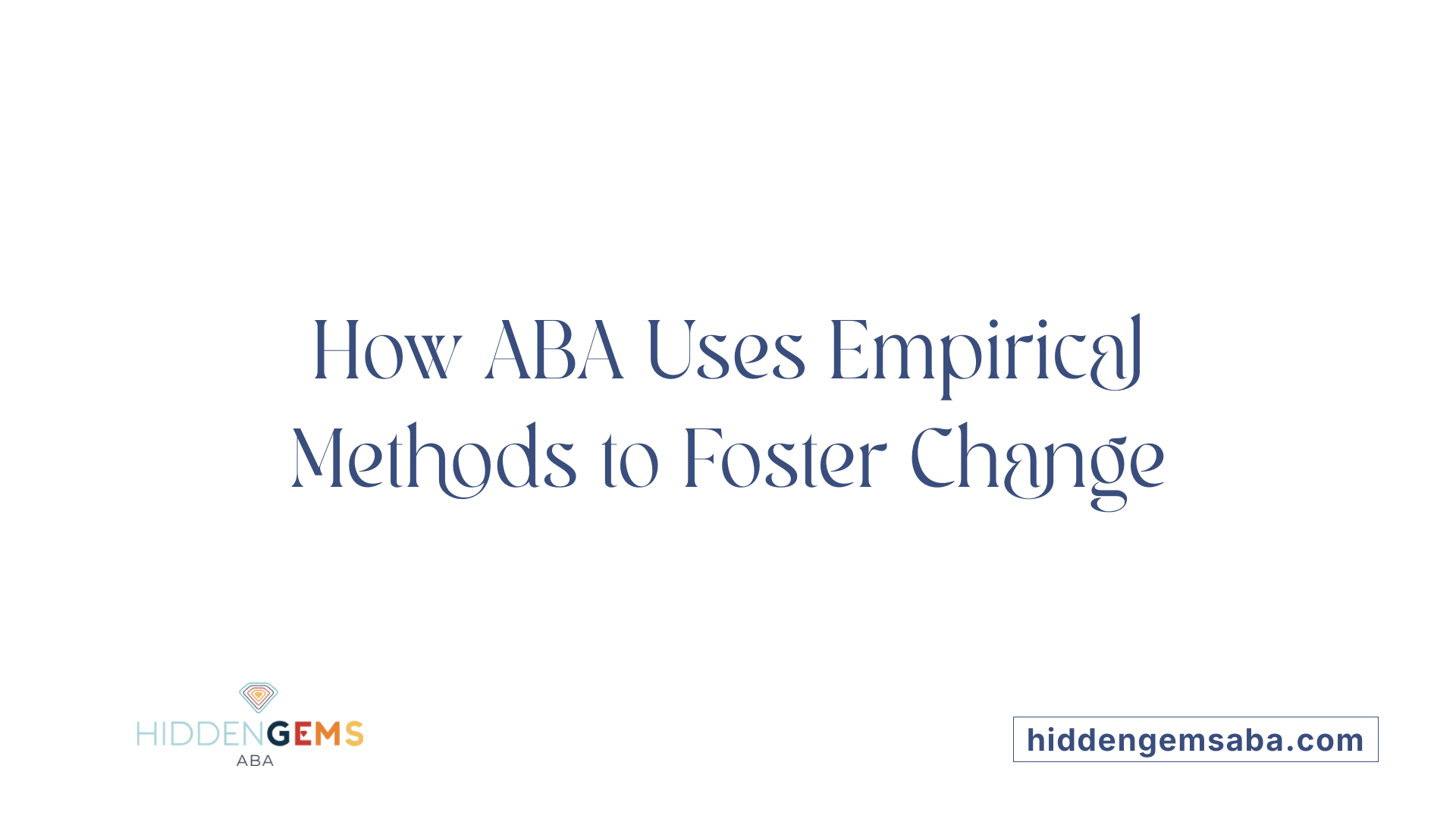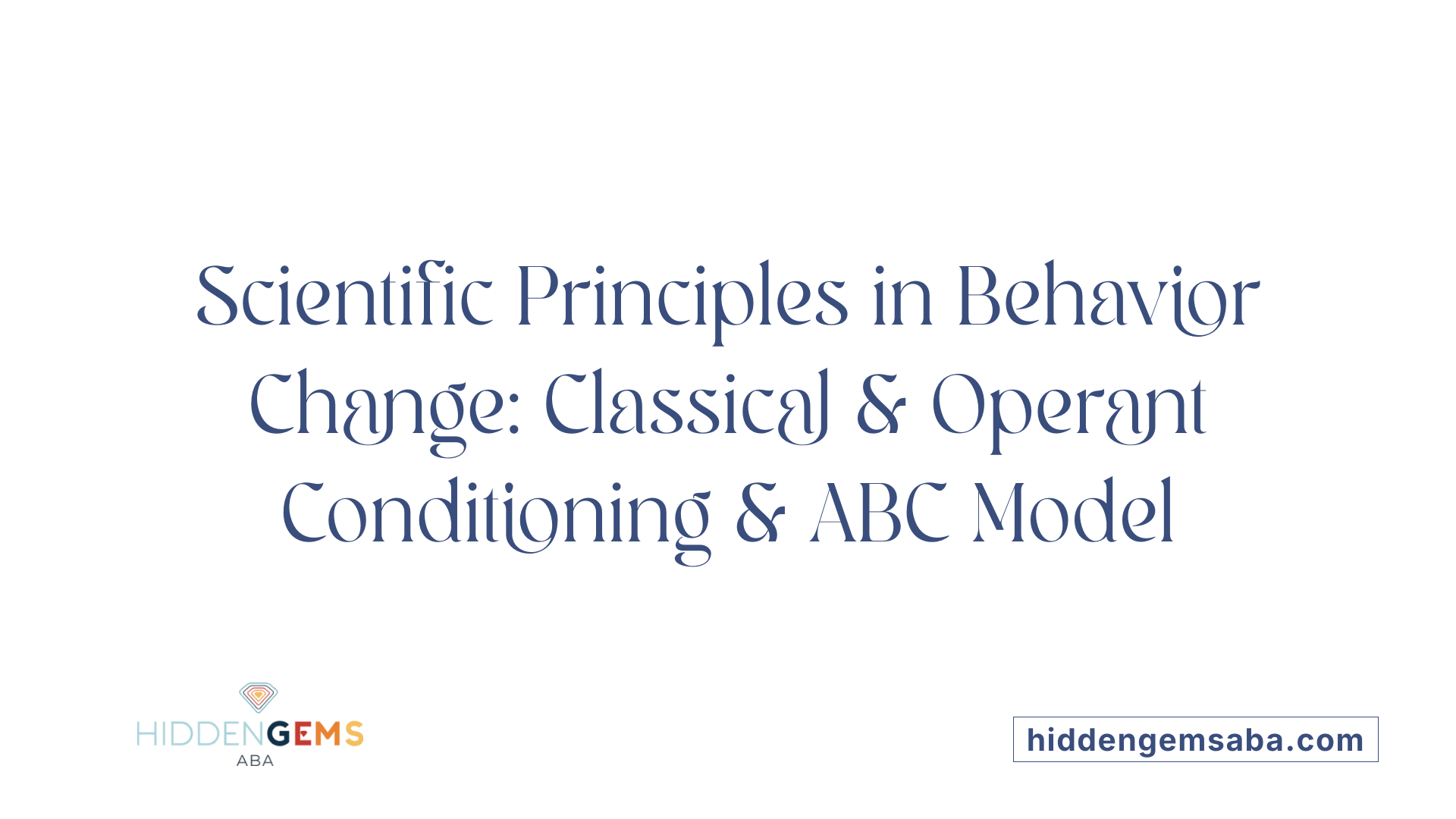Understanding ABA: A Scientific Perspective on Behavioral Change
Applied Behavior Analysis (ABA) is a scientifically grounded therapy that harnesses the principles of learning and behavior to facilitate meaningful change. Rooted in decades of research, ABA employs systematic methods based on behavioral psychology to enhance desirable behaviors and diminish problematic ones, particularly in individuals with autism spectrum disorder (ASD). This article explores the core scientific principles, psychological theories, and research evidence underpinning ABA, illustrating how it translates learning theories into practical, effective interventions.
The Scientific Principles and Rationale of ABA Therapy

What are the scientific principles and rationale underlying ABA therapy?
Applied Behavior Analysis (ABA) therapy is built upon the scientific foundations of learning and behavior. Central to this approach is operant conditioning, a concept developed by B.F. Skinner, which explains how behaviors are influenced by their consequences. When a behavior is followed by a positive outcome, it is more likely to occur again—this process is called reinforcement.
Reinforcement can be positive, involving the addition of a rewarding stimulus like praise or a favorite activity, or negative, where an unpleasant stimulus is removed to encourage behavior. Both aim to increase desirable behaviors. Conversely, behaviors can be decreased through extinction or punishment, but ABA emphasizes positive strategies to promote learning.
Behavior functions are understood to be driven by specific motives such as gaining attention, escaping from uncomfortable situations, obtaining tangible items, or sensory stimulation. Recognizing these functions helps practitioners design interventions that directly address the underlying needs motivating behaviors.
To analyze and modify behavior comprehensively, ABA employs the ABC model—Antecedent, Behavior, Consequence. An antecedent is a stimulus or event that triggers a behavior, which then produces a consequence that influences the likelihood of the behavior recurring. This model enables precise identification of factors influencing behaviors and guides the development of effective strategies.
Overall, ABA's rationale lies in applying rigorous, evidence-based methods that systematically modify behaviors. By understanding the environmental and psychological factors at play, ABA fosters meaningful, lasting change, enhancing learning, communication, and social skills for individuals, especially those with autism. Its scientific basis ensures interventions are tailored, effective, and grounded in proven principles of behavior science.
Foundations of Learning: Classical Conditioning, Operant Conditioning, and the ABC Model

What are the theoretical foundations of ABA, including classical conditioning, operant conditioning, and the three-term contingency?
Applied Behavior Analysis (ABA) is built on well-established psychological theories that explain how behaviors are acquired, maintained, and changed. These include classical conditioning, operant conditioning, and the ABC (Antecedent-Behavior-Consequence) model.
Classical conditioning, first demonstrated by Ivan Pavlov through his experiments with dogs, involves creating associations between stimuli. For example, if a bell (stimulus) is consistently paired with food, the dog begins to salivate when hearing the bell alone. This form of learning explains how certain stimuli can trigger automatic responses and is used in ABA to establish new associations.
Operant conditioning, developed by B.F. Skinner, emphasizes learning through consequences. Behaviors followed by reinforcement tend to increase, while those followed by punishment tend to decrease. Reinforcement can be positive (adding a pleasant stimulus) or negative (removing an unpleasant stimulus). For instance, giving praise after a child completes a task encourages repetition of that behavior.
The ABC model is central to ABA practice. It describes how environmental triggers (antecedents) lead to behaviors, which are then followed by outcomes (consequences) that influence future responses. For example, a child may be prompted to ask for help (behavior) following a difficult task (antecedent), and positive reinforcement (praise or a reward) after asking correctly will likely promote asking for help in future situations.
Together, these foundations highlight the importance of observable behaviors and environmental factors, allowing therapists to systematically analyze and modify behavior. Data collection and ongoing assessment ensure that interventions are tailored and effective, leading to meaningful, longer-lasting behavioral change. Overall, these principles make ABA a scientific and adaptable approach for skill development and behavior management.
Behavioral Learning Processes in ABA
What behavioral learning processes are involved in ABA therapy?
Applied Behavior Analysis (ABA) relies on core learning processes rooted in behavioral psychology. These processes help shape, reinforce, and modify behavior to support individuals, particularly those with autism spectrum disorder.
One of the main processes is reinforcement, which can be positive—adding a pleasant stimulus to increase a behavior—or negative—involving the removal of an unpleasant stimulus. Reinforcement encourages desired behaviors to happen more frequently.
Prompting and fading are techniques used to guide learners toward correct responses. Prompts provide assistance or cues, which are gradually withdrawn as independence grows. This supports learning new skills step-by-step.
Shaping involves reinforcing small successful steps that gradually become more complex, helping children acquire new behaviors that they couldn't perform before.
Extinction is used to reduce problematic behaviors by withholding reinforcement, meaning the behavior no longer produces a rewarding outcome, leading to a decrease over time.
In addition to these, ABA employs modeling, where behaviors are demonstrated for learners, chaining to link smaller skills into complete activities, and script fading to reduce reliance on verbal prompts.
Data collection and analysis are integral to these processes. Therapists continually monitor behaviors, record progress, and analyze patterns to adjust intervention strategies.
Together, these evidence-based learning methods create a systematic approach that promotes meaningful skill development, generalization across settings, and long-term behavior change. This combination ensures ABA remains an adaptable and effective therapy for a wide range of behavioral improvements.
Research Evidence Validating ABA Effectiveness
Numerous studies and comprehensive reviews support the effectiveness of Applied Behavior Analysis (ABA) therapy in improving the lives of individuals with autism spectrum disorder (ASD). Meta-analyses, which gather and analyze data from multiple research studies, consistently show positive outcomes.
For example, a detailed meta-analysis of 14 randomized controlled trials involving 555 children found that ABA significantly enhances social skills, communication, and expressive language. However, it also noted that receptive language improvements were less pronounced. This research underscores ABA's strength in fostering essential communication development.
In addition to meta-analyses, over 20 large-scale studies have demonstrated that intensive ABA programs can lead to substantial gains. These include higher IQ scores, better language acquisition, improved adaptive behaviors, and increased independence in daily activities.
Notably, reputable organizations like the U.S. Surgeon General and the American Psychological Association endorse ABA as an evidence-based approach. Their support is grounded in a wealth of scientific evidence showing that long-term, intensive ABA interventions can produce meaningful behavioral and developmental improvements.
Overall, the body of research affirms that ABA is a scientifically validated method capable of advancing various skills crucial for successful integration and quality of life for individuals with autism.
Methodologies and Techniques in ABA Based on Scientific Principles
What methodologies and techniques does ABA use based on scientific principles?
Applied Behavior Analysis (ABA) employs a range of scientifically supported methods designed to promote positive behavior and reduce problematic behavior. These techniques are rooted in fundamental learning principles such as operant conditioning and classical conditioning.
One of the primary methods used in ABA is Discrete Trial Training (DTT). DTT is a structured, highly focused approach where a skill is broken down into small, discrete steps. Each trial involves a clear cue or prompt, the child's response, and a consequence—either reinforcement or correction. This method allows precise measurement of progress and is especially useful for teaching foundational skills.
Another approach is Natural Environment Teaching (NET), which emphasizes child-centered learning in everyday settings. Rather than structured sessions, NET uses natural interactions and naturally occurring opportunities to motivate learning. This strategy increases the likelihood that skills will generalize across different environments.
Behavior chaining involves linking smaller, individual steps into a comprehensive activity or skill. For example, teaching how to brush teeth may involve chaining steps from picking up a toothbrush to rinsing and spitting. This helps in teaching complex behaviors by gradually adding and reinforcing each step.
Popular Techniques Supporting Behavior Change
- Reinforcement: A cornerstone of ABA, reinforcement involves providing a reward to increase desired behaviors. It can be positive, such as praise or tangible rewards, or negative, where a stimulus is removed to encourage behavior.
- Prompting and Fading: Prompts are cues or assistance given to encourage a response. Over time, prompts are gradually faded to foster independent responses, essential for skill mastery.
- Modeling: Demonstrations of desired behavior serve as a guide for learners, providing a clear example for imitation.
- Extinction: This technique involves withholding reinforcement for problematic behaviors, reducing their occurrence over time.
Utilizing Data for Personalized Interventions
Across all techniques, data collection is integral. Practitioners track behaviors meticulously to assess progress and adjust interventions accordingly. Functional Behavioral Assessments (FBA) help identify the purpose behind behaviors, enabling tailored and effective interventions.
Overall, ABA’s methodologies and techniques are adaptable and evidence-based. By analyzing antecedents and consequences within the ABC framework, therapists can promote meaningful skill development tailored to each individual’s needs.
Impact of ABA on Individuals with Autism from a Scientific Perspective
How does ABA therapy impact individuals with autism from a scientific perspective?
Applied Behavior Analysis (ABA) is a scientifically validated approach grounded in behavioral psychology principles. By systematically analyzing how antecedents (triggers), behaviors, and consequences (rewards or punishments) interact, ABA helps to identify patterns that influence behavior.
The core of ABA involves reinforcing positive behaviors using techniques like positive reinforcement, where desirable actions are rewarded with praise, tokens, or access to preferred activities. This approach encourages the repetition and strengthening of beneficial skills across various areas.
Research has shown that intensive, individualized ABA programs can significantly improve communication, social interactions, adaptive skills (such as dressing, toileting, and eating), and reduce problematic or harmful behaviors. These effects are most evident when interventions are sustained over time and tailored to each person’s unique needs.
Numerous studies and meta-analyses support ABA’s effectiveness. For instance, research by Dr. O. Ivar Lovaas in 1987 demonstrated remarkable improvements in children with autism who received early, intensive ABA therapy, with some reaching typical developmental milestones.
Supported by organizations such as the US Surgeon General and the American Psychological Association, ABA is regarded as the most evidence-based treatment for autism spectrum disorder. It not only promotes skill development but also fosters greater independence, enabling individuals to navigate daily life more effectively.
Despite some challenges in implementation, the scientific consensus affirms that ABA’s strategic approach to behavior modification can lead to meaningful, long-lasting change, enhancing quality of life and societal participation for many individuals with autism.
Understanding Behavior Through a Scientific Lens and Neuroscientific Insights
How does behavior analysis help in understanding behavior through a scientific lens?
Behavior analysis approaches understanding behavior as a scientific discipline by focusing on measurable and observable actions. It systematically studies how environmental factors—like stimuli and consequences—influence behavior. Using empirical methods, it employs concepts such as classical and operant conditioning to explain how actions are learned and maintained over time.
Central to this approach is the use of precise methodologies, including operational definitions and the ABC model (Antecedent, Behavior, Consequence). These methods enable professionals to objectively observe, record, and analyze behaviors within specific contexts.
By relying on systematic experimentation and data collection, behavior analysis can predict how behaviors develop, identify triggers, and determine effective strategies for behavior modification. This scientific framework helps practitioners design targeted interventions, ensuring strategies are grounded in evidence, leading to better outcomes across various settings.
Ultimately, the discipline’s roots in empirical research empower it to provide a clear, rigorous understanding of why behaviors occur and how they can be systematically changed, making it a robust approach to studying human actions.
Bridging Science and Practice in Behavioral Interventions
In summary, ABA therapy is deeply rooted in the scientific principles of learning and behavior, employing systematic, evidence-based methods derived from psychology, neuroscience, and behavior analysis. Its use of reinforcement, systematic data collection, and individualized programming demonstrates how scientific understanding translates into effective intervention strategies. Recognition from major health organizations underscores its scientific legitimacy and effectiveness. Ultimately, ABA exemplifies how rigorous scientific research can lead to practical, impactful solutions that improve the quality of life for individuals with autism and others seeking behavioral change, reaffirming its role as a cornerstone of behavioral science.
References
- Applied Behavior Analysis (ABA)
- The Facts Behind Behavioral Analysis
- 3 Scientific Concepts Behind Applied Behavior Analysis
- The effectiveness of applied behavior analysis program ...
- The Science Behind ABA: How Learning Theory Shapes ...
- ABA Therapy: Backed by Data, Built on Behavioral Science
- The Science Behind ABA Therapy
- Applied Behavior Analysis (ABA)






